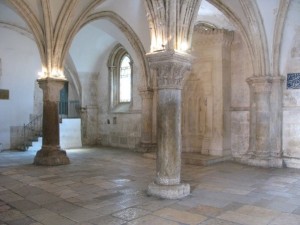By John W. Welch
The celebration of Easter usually begins with Jesus’s triumphal entry into Jerusalem on Palm Sunday. But the events of Passion Week cannot be understood without backing up to the event just a few days earlier in Bethany, just over the hill to the east of Jerusalem. That event was the raising of Lazarus at the home and at the behest of Martha and Mary. That personal favor, offered by Jesus to Mary, Martha, and Lazarus whom he loved (John 11:5), is reported is detail in John 11, right before his entry into Jerusalem in John 12.
Without seeing this as background, it is hard to imagine a reason why a large multitude of people would have followed Jesus into Jerusalem shouting Hosanna! Save us now! It was widely known that he had saved Lazarus from the grave. Many of the leading Jews in Jerusalem had come out to Mary’s home “and had seen the things which Jesus did” and they “believed on him” (11:45). John makes it clear that the crowd was especially excited by the raising of Lazarus: The people who were “with him when he called Lazarus out of his grave, and raised him from the dead” were talking openly and strongly and did “bear record,” and because of that, “for this cause” the people in the city came out and “also met him, for that they heard that he had done this miracle” (12:17-18).
In addition, without seeing the raising of Lazarus as background to the Passion Week, it is perhaps even harder to imagine why the chief priests turned Jesus’s popularity into utter abandonment and were able to move so quickly and tactically to arrest him, condemn him, take him to Pilate, accuse him, get permission to execute him, and complete the crucifixion, start to finish, all within about ten hours’ time.
How could that have happened? Perhaps the raising of Lazarus, which was the greatest and most closely observed of all of Jesus’s miracles, was simply too powerful, too convincing, too threatening, or too unusual, and at the same time too close to Jerusalem for it have been ignored, one way or the other. Either it was the greatest manifestation ever seen of divine power in the Temple district, or it was the most deceptive act ever imagined by a clever imposter. While many saw it the first way and believed on Jesus, others continued to fear that Jesus had tricked or “deceiveth the people” (John 7:12, 47) and “some of them went their ways to the Pharisees, and told them what things Jesus had done” (11:46). This report, which must have been tantamount to the filing of an official complaint, galvanized the deep division between the two extremes that confronted Jesus as he humbly rode into Jerusalem on the day after his last ordinary Sabbath.
Indeed, before that triumphal day arrived, other important legal steps had already been set into motion. John 11:47 reports: “Then gathered (synēgagon) the chief priests and Pharisees a council (synedrion).” More than just getting together for an informal conversation or committee meeting, this assembly must have been something of an official gathering, the calling of a session of the Sanhedrin with both parties, the chief priests (the Sadducees) and the Pharisees involved. What was their concern? They wondered “What do we do?” They felt the need to take action. They readily recognized that Jesus had not just worked miracles, but that his many miracles constituted signs, pointing to something more than just doing good. The Sanhedrin found that Jesus in fact had given “many signs” (polla sēmeia). If these signs or wonders led people to “go after other gods,” those miracles were evil and that wonderworker “shall be put to death” (Deuteronomy 13:2, 5).
As they discussed the case, some argued, “If we let him thus alone (aphōmen),” or if we allow him to go on in this way, or forgive him, or condone his conduct, everyone (pantes) will believe on him (pisteusountes eis auton, or trust and have faith in him), “the Romans shall come and take away both our place and nation” (11:48). They fear that “the place” (ton topon, or the temple) and the people (to ethnos, the people of Israel) would be arousin, that is, destroyed, taken away, swept off, conquered by force, even by killing.
Caiphas, the high priest, however, rejected these arguments (saying “Ye know nothing at all”) and made his case based on logic (logizesthe), that it would be better, advantageous, or helpful (sympherei) for us that one man die on behalf of (hyper with the genitive) the people and not the whole people be destroyed (11:50). This he did not say on his own personal authority, but acting officially as the High Priest (11:51) he actually and authoritatively (even if unwittingly) prophesied that Jesus would die for the people, and not just for the people but so that the scattered (dieskorpismena) children of God could be gathered into one (11:52).
This gathering and these words have a ring of legal finality to them, and thus the Gospel of John continues, “Then from that day forth they took counsel (or were legally resolved together, ebouleusanto) that they would kill him.
As people compare the account of the trial of Jesus in Matthew, Mark, and Luke, which occurs after the arrest of Jesus in the Garden of Gethsemane, people wonder why there is no legal trial in John 18, when Jesus is taken from the Garden of Gethsemane to Annas and then is handed over directly to Pilate where he is tried. In the synoptic gospels, members of the Sanhedrin meet right after the arrest of Jesus and conduct something of a hearing, although not really a full trial. But even less of a trial occurs before the high priest in John 18. Thus the question often asked is where is the Jewish trial in the Gospel of John? The answer may well be: In John 11 we have a convening of the Sanhedrin, formal accusations, deliberation, reasoning, and even reaching of a verdict. This reading of John is confirmed in several ways.
First, following this decision, an order was issued that anyone knowing of the whereabouts of Jesus needed to report that information so that he could be captured. “Now both the chief priests and the Pharisees had given a commandment, that, if any man knew where he were, he should shew it, that they might take him” (11:57).
Second, plans for the arrest of Lazarus were also contemplated: And “the chief priests consulted that they might put Lazarus also to death; because that by reason of him many of the Jews went away, and believed on Jesus” (12:10-11). Presumably, Lazarus was either an accomplice or at least a witness of what Jesus had done in raising him from the tomb, which some of the Jews thought was some kind of legally actionable trick or deception.
Third, although Jesus was not present at that hearing, none of the members of the Sanhedrin doubted the factual accuracy of the allegations against Jesus, and neither does the Gospel of John doubt that Jesus worked many controversial miracles. Upon his arrest, Jesus presumably would have been given some information about the legal determination that had been reached against him, with perhaps a chance to recant and change his behavior. Something like that opportunity was given to Jesus in John 18:19-23, but there would have been no need to reconvene the entire Sanhedrin to vote again at that time on something that the Sanhedrin had previously decided.
Finally, the determination and action of the chief priests would not have come as any surprise to Jesus. Entering the Temple the day after his triumphal entry into Jerusalem, Jesus was immediately asked by the chief priests and the elders, “By what authority doest thou these things? And who gave thee this authority?” (Matt. 21:23). These were questions Jesus had been asked before, when the scribes (lawyers) had come up from Jerusalem to Galilee at the beginning of Jesus’s ministry. On that occasion, the scribes came to investigate by which “authority” (Mark 1:27) Jesus was performing his miracles. If he performed miracles by the power of God and to God’s glory, his miracles were beyond reproach. But if it was “by the prince of the devils [that he] casteth he out devils” (Mark 3:22), then he was committing a capital offense for which he could be put to death.
By asking this very question once again of Jesus right after the raising of Lazarus, the chief priests and the elders would have been acting on the assurance that his many signs and wonders, and most recently of all his conspicuous raising of Lazarus, warranted his death. Having been confronted by this very challenge on previous occasions, Jesus could well have anticipated—as he walked toward Bethany to answer the plea of his dear friends to come and heal their dying brother Lazarus—that by openly raising Lazarus from the dead, he was effectively signing his own death warrant.



